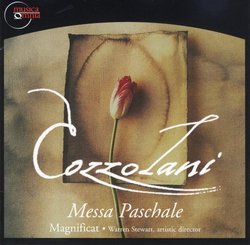| All Artists: Magnificat Ensemble;Warren Stewart Title: Easter Mass Members Wishing: 0 Total Copies: 0 Label: Musica Omnia Original Release Date: 1/1/2000 Re-Release Date: 6/15/2002 Album Type: Single Genres: Pop, Classical Styles: Vocal Pop, Opera & Classical Vocal, Chamber Music, Historical Periods, Baroque (c.1600-1750), Early Music Number of Discs: 1 SwapaCD Credits: 1 UPC: 801890020921 |
Search - Magnificat Ensemble;Warren Stewart :: Easter Mass
 | Magnificat Ensemble;Warren Stewart Easter Mass Genres: Pop, Classical
|
Larger Image |
CD Details |
CD ReviewsSensuous Sounds Behind the Screen Giordano Bruno | Wherever I am, I am. | 12/07/2009 (5 out of 5 stars) "Across from the Duomo of Milan in the mid 17th Century, in the 'exterior chapel' of the Convent of Santa Radegonda, cloistered nuns performed musical masses on feast days, complete with polyphonic motets appropriately replacing portions of the liturgy as well as with instrumental accompaniment. They performed behind a screen, unseen by visitors; the only male participant would have been the priest, who stood outside the screen. One visitor, the priest Sebastiano Locatelli, testified to the quality of their music: "At Santa Radegonda, a convent of nuns, I could not discern whether the singing voices were earthly or celestial..." Much of the music the sisters sang was composed by one of their own 'Brides of Christ', Chiara Margarita Cozzolani, who took vows in her teens and who stayed in the convent throughout her life, eventually becoming prioress and abbess. Cozzolani was just one of a dozen or more cloistered nuns whose music was actually published in Italy in the 17th C, but she has become recognized in our times as the most gifted woman composer of the era, whose music bears comparison with that of the greatest male composers, even with Claudio Monteverdi.
No music I've ever heard has more instantly evoked a sense of spiritual ecstasy, of the mystic union of the Soul with God poeticized by Saint John of the Cross and Santa Teresa, than the music of Sister Chiara. I think you'll hear this exultation in the first bar of the 4-voice Kyrie that bursts like aerial fireworks from the somber plainchant introit. The four voices are all women's, but the compositional artifice and the use of basso continuo violone/theorbo gives the impression of a full choir of humanity. Their timbre is stunningly sensuous... sensual... carnally beautiful. I rather suspect that more than one male listener in the chiesa exteriore of Santa Radagunda experienced as much a physical 'elevation' as a religious one. This performance is intended to recreate the totality of a Paschal mass, including the chanting of the lessons and propers. The celebrant, Hugh Davies, sounds quite convincing as a musically sensitive priest; his dry masculine tones render the ecstatic outbursts of the women's voices all the more angelic. The nine women singing on this CD -- Jennifer Ellis, Andrea Fullington, Suzanne Elder Wallace, Karen Clark, catherine Webster, Ruth Escher, Margaret Bragle, Linda Liebschutz, and Deborah Rentz-Moore -- include several who have also recorded with Paul Hillier's Theater of Voices, the American Bach Society, Philharmonia Baroque Orchestra, and numerous other prominent Early Music ensembles. The continuo players are David Tayler on theorbo, John Dornenburg on violone, and Hanneke van Proosdij on organ. Marginficat founder and director Warren Stewart conducts. Magnificat has also recorded Cozzolani's "Vespers" on 2 CDs, with a third CD offering a 17-minute explication of Cozzolani's music and career by Warren Stewart. Both recordings are extremely fine, Magnificat is now undertaking to record all the rest of the surviving music by Cozzolani, a project that will take them about two years. They have announced that the performances will be released both on physical disks and as downloads, the latter available to 'subscribers' as the project progresses. Based on the two earlier CD releases, and on the singers currently committed to the project, I fully expect it to be a musical treasure. That's one reason to consider subscribing; the other is altruistic, the noble urge to support an ensemble based in the USA but performing without the subsidies available to European ensembles, including many of less merit. Details are available at the ensemble's website." |

 Track Listings (19) - Disc #1
Track Listings (19) - Disc #1